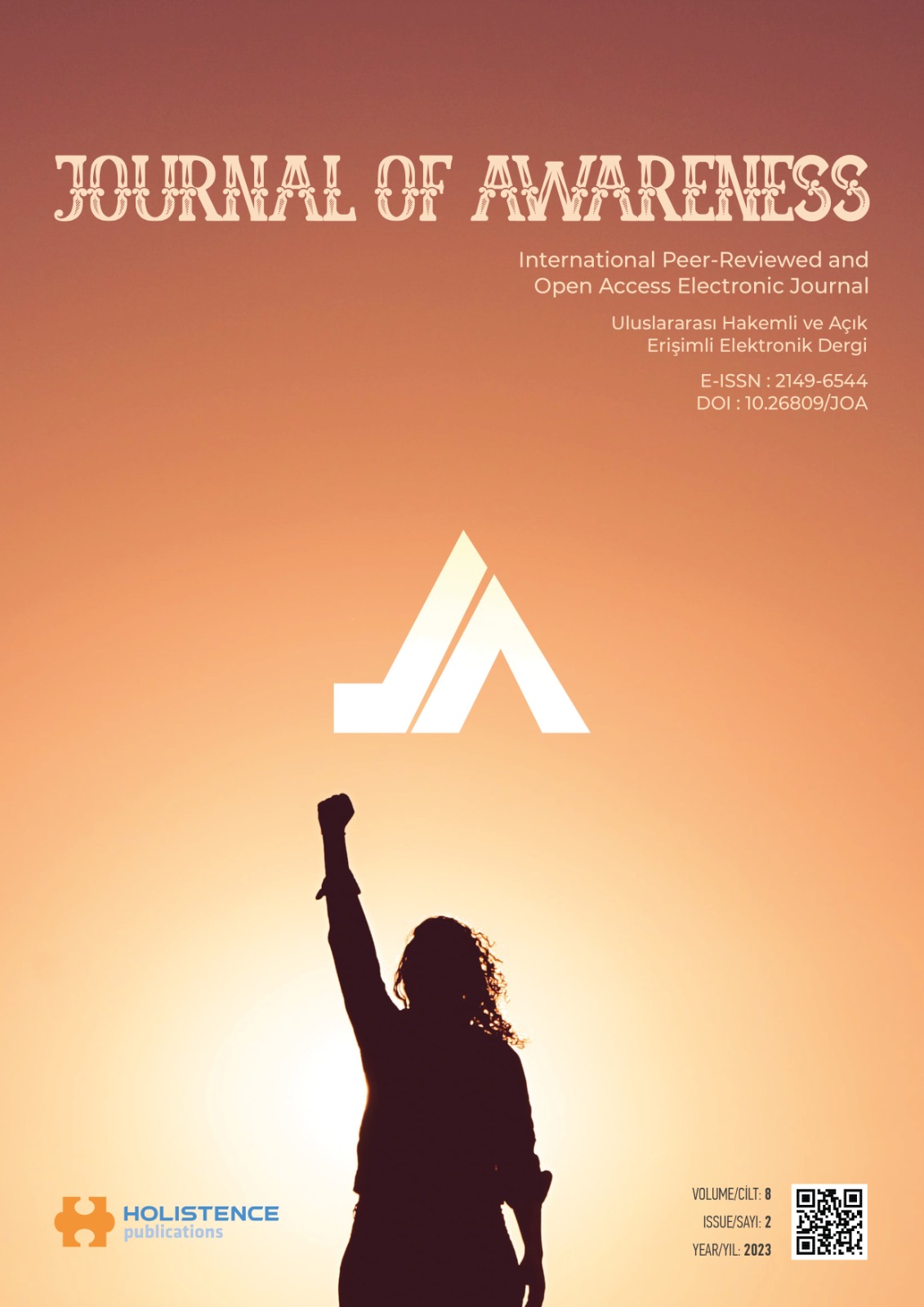Analysis of stalking as a risk factor for intimate partner femicide in Turkey
DOI:
https://doi.org/10.26809/joa.2016Anahtar Kelimeler:
Femicide- Stalking- Stalker- Victim- PerpetratorÖzet
The aim of the study is to reveal the picture of femicide, which continues to exist as a current problem in Turkey, and to analyze the stalking elements that manifest as a serious threat before the murder. This study is based on the data provided from “Anıt Sayaç / The Monument Counter”.. The “Anıt Sayaç” is a platform that was established on the internet to keep alive the memory of women who died due to violence against women in Turkey, and contains daily updated news on femicide. The women victims have been analyzed under several criteria such as whether they were faced to stalking, by whom the stalking was carried out, which stalking behaviors were, and whether there was a restraining or protection order. As a result the investigation of 1250 femicide in total for the years 2019, 2020 and 2021, it was encountered that 102 women were subjected to being stalked before they were killed. 65% of women exposed to stalking were stalked by a spouse/boyfriend/partner or ex-spouse/ex-boyfriend/ex-partner, and 15% of by someone they knew. It was observed that 22.5% of the 102 women who were subjected to stalking had a restraining or protection order. Most of the women were subjected to stalking by being followed and threatened. As a result, it can be said that the murdered women were subjected to stalking beforehand, this situation constitutes a risk factor for femicide, and the restraining or protection order were insufficient. At this point, it can be stated that policies and practices developed with a holistic approach towards stalking and femicide are important for a solution.
İndirmeler
Referanslar
AKDUMAN, İ., ÜNSALVER, B., CAVLAK, M., ORAL, G. & CANSUNAR N. (2006). Takipçi Tacizcilik- Stalking. Adli Psikiyatri Dergisi, 3 (3-4): 25-33
BLOCK, C. R. (2000). Chicago Women’s Health Risk Study, 1995–1998. Chicago, Illinois Inter-University Consortium for Political ve Social Research.
CAMPBELL, J. C., WEBSTER, D., KOZIOL-MCLAIN, J., BLOCK, C., CAMPBELL, D., CURRY, M. A., et al.(2003). Risk Factors for Femicide in Abusive Relationships: Results from A Multisite Case Control Study. American Journal of Public Health, 93(7), 1089-1097.
CAKMUT YENERER, Ö. (2021). Israrlı Takip (Stalking), Kişinin Huzur ve Sükununu Bozma ve Türk Ceza Hukuku Bakımından Genel Değerlendirme [online]. Balıkesir Barosu, https://balikesirbarosu.org.tr/medya/balikesir-barosu-dergisi-sayi-1, (Date Accessed: 26.01.2023).
DOĞAN, R. (2014). Kadına Yönelik Şiddetin Bir Türü Olarak, Israrlı Takip (Stalkıng) Kavramı ve Suçu, Ankara Barosu Dergisi, 2014/2.
ELLISON, L. & AKDENIZ, Y. (1998). Cyber-Stalking: the Regulation of Harassment on the Internet. Criminal Law Review, Special Edition: Crime, Criminal Justice and the Internet, 29-48.
ELLIS, D. & DEKESEREDY, W. (1996). The Wrong Stuff: An İntroduction To The Sociological Study Of Deviance. Scarborough, Ont.: Allyn & Bacon Canada; 2nd ed.
GARTNER, R., DAWSON, M., & CRAWFORD, M. (1998). Women Killing: Intimate Femicide in Ontario, 1974-1994. Resources for Feminist Research, 26, 151-173.
KARATAŞ, K., & ERÜKÇÜ AKBAŞ, G., (2017). Türkiye’de Kadın Cinayetlerinin Medyaya Yansıması: 2015- 2016 Yılları Üzerinden Bir Değerlendirme. Uluslararası Sosyal Hizmet Kongresi (pp.72-73). Ankara, Turkey.
MCFARLANE, J., CAMPBELL, JC., WİLT, S., SACHS, C., ULRICH, Y. & XIAU XU (1999). Stalking ve Intimate Partner Femicide. Homicide Studies; 3, 300–316.
MELOY, JR. (1998) The Psychology of Stalking: Clinical and Forensic Perspectives. London: Academic Press.
OZAR, S. (2022). Israrlı Takip Suçu (TCK m. 123/A). Ankara Üni. Hukuk Fak. Dergisi, 71 (3): 1397-1430.
POLAT, O., GURGEZOGLU YAPAR, E., REVA, Z., NALBANTOGLU, G., AKCA, B. & YILMAZ, R. (2021). Israrlı Takip/Stalking Raporu: April 2021. İMDAT Association, https://www.imdat.org/raporlarimiz.
SPITZBERG, B. H. (2002). The Tactical Topography Of Stalking Victimization And Management. Trauma, Violence, & Abuse, 3, 261-288.
SEN, E. & SERDAR, C. (2022). Huzuru ve Sükunu Bozma Suçu ve Israrlı Takip (Stalking) [online]. Ersan Şen Hukuk ve Danışmanlık, https://sen.av.tr/tr/makale/huzuru-ve-sukunu-bozma-sucu-ve-israrli-takip-(stalking), (Date Accessed: 26.01.2023).
TASTAN, C. & KUCUKER YILDIZ A. (2018). Türkiye’de Kadın Cinayetleri: 2016 Yılı Veriler ve Analizler. Polis Akademisi Yayınları.
TASTAN, C. & KUCUKER YILDIZ A. (2019). Kadına Yönelik Ölümcül Şiddet (1.Baskı). Polis Akademisi Yayınları.
Turkish Grand National Assembly (TGNA) web site: https://www5.tbmm.gov.tr//sirasayi/donem27/yil01/ss323.pdf, (Date Accessed: 26.01.2023)
Turkish Criminal Code, No.5237 (2004). Official Gazette of the Republic of Turkey, 25611, 26 September 2004.
TURKOGLU, S. (2019). Türk Ceza Hukuku Açısından Israrlı Takip. Galatasaray Üniversitesi Sosyal Bilimler Enstitüsü Kamu Hukuku Anabilim Dalı, YÖK Tez.
UYUMAZ, A. & AKDAG, R. (2015). Türk Özel Hukukunda Şiddet ve Israrlı Takip Kavramı İle Israrlı Takip Mağdurunun Korunması. Gazi Üniversitesi Hukuk Fakültesi Dergisi C. XIX, Y. 2015, Sa. 2, 45-94.
WILSON, M. & DALY, M. (1993). Spousal Homicide Risk and Estrangement. Violence and Victims, 8(1), 3.
İndir
Yayınlanmış
Nasıl Atıf Yapılır
Sayı
Bölüm
Lisans
Telif Hakkı (c) 2023 Holistence Publications

Bu çalışma Creative Commons Attribution 4.0 International License ile lisanslanmıştır.
Yazarlar, makale Journal of Awareness’de yayınlanmak üzere kabul edildiğinde.makalenin içeriğindeki tüm telif haklarını, Rating Academy Ar-Ge Yazılım Yayıncılık Eğitim Danışmanlık ve Organizasyon Ticaret Ltd. Şti’ne devrederler. Yazarlar, patent hakları gibi telif hakkı dışındaki tüm mülkiyet haklarını saklı tutar.
Bu makalede yazar olarak listelenen herkes çalışmaya önemli, doğrudan, entelektüel katkılar yapmış olmalı ve bunun için kamu sorumluluğu almalıdır.
Bu makale daha once yayınlanmamış ve başka dergilerde yayınlanmak üzere gönderilmemiştir.











